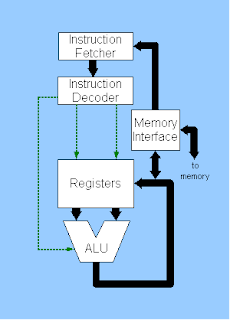hi welcome in computer's world.Here you get the information about computer programing language such as C,c++ java, Data structure, visual basic and many more . You also find computer hardware,computer networking,database management system related things and its study.
Monday, August 24, 2009
program langauge
Sunday, August 2, 2009
c programing
1. main()
{
char string[]="Hello World";
display(string);
}
void display(char *string)
{
printf("%s",string);
}
Answer:
Compiler Error : Type mismatch in redeclaration of function display
Explanation :
In third line, when the function display is encountered, the compiler doesn't know anything about the function display. It assumes the arguments and return types to be integers, (which is the default type). When it sees the actual function display, the arguments and type contradicts with what it has assumed previously. Hence a compile time error occurs.
2. main()
{
int c=- -2;
printf("c=%d",c);
}
Answer:
c=2;
Explanation:
Here unary minus (or negation) operator is used twice. Same maths rules applies, ie. minus * minus= plus.
Note:
However you cannot give like --2. Because -- operator can only be applied to variables as a decrement operator (eg., i--). 2 is a constant and not a variable.
3. #define int char
main()
{
int i=65;
printf("sizeof(i)=%d",sizeof(i));
}
Answer:
sizeof(i)=1
Explanation:
Since the #define replaces the string int by the macro char
4. main()
{
int i=10;
i=!i>14;
Printf ("i=%d",i);
}
Answer:
i=0
Explanation:
In the expression !i>14 , NOT (!) operator has more precedence than ‘ >’ symbol. ! is a unary logical operator. !i (!10) is 0 (not of true is false). 0>14 is false (zero).
5. #include
main()
{
char s[]={'a','b','c','\n','c','\0'};
char *p,*str,*str1;
p=&s[3];
str=p;
str1=s;
printf("%d",++*p + ++*str1-32);
}
Answer:
77
Explanation:
p is pointing to character '\n'. str1 is pointing to character 'a' ++*p. "p is pointing to '\n' and that is incremented by one." the ASCII value of '\n' is 10, which is then incremented to 11. The value of ++*p is 11. ++*str1, str1 is pointing to 'a' that is incremented by 1 and it becomes 'b'. ASCII value of 'b' is 98.
Now performing (11 + 98 – 32), we get 77("M");
So we get the output 77 :: "M" (Ascii is 77).
6. #include
main()
{
int a[2][2][2] = { {10,2,3,4}, {5,6,7,8} };
int *p,*q;
p=&a[2][2][2];
*q=***a;
printf("%d----%d",*p,*q);
}
Answer:
SomeGarbageValue---1
Explanation:
p=&a[2][2][2] you declare only two 2D arrays, but you are trying to access the third 2D(which you are not declared) it will print garbage values. *q=***a starting address of a is assigned integer pointer. Now q is pointing to starting address of a. If you print *q, it will print first element of 3D array.
7. #include
main()
{
struct xx
{
int x=3;
char name[]="hello";
};
struct xx *s;
printf("%d",s->x);
printf("%s",s->name);
}
Answer:
Compiler Error
Explanation:
You should not initialize variables in declaration
8. #include
main()
{
struct xx
{
int x;
struct yy
{
char s;
struct xx *p;
};
struct yy *q;
};
}
Answer:
Compiler Error
Explanation:
The structure yy is nested within structure xx. Hence, the elements are of yy are to be accessed through the instance of structure xx, which needs an instance of yy to be known. If the instance is created after defining the structure the compiler will not know about the instance relative to xx. Hence for nested structure yy you have to declare member.
9. main()
{
printf("\nab");
printf("\bsi");
printf("\rha");
}
Answer:
hai
Explanation:
\n - newline
\b - backspace
\r - linefeed
10. main()
{
int i=5;
printf("%d%d%d%d%d%d",i++,i--,++i,--i,i);
}
Answer:
45545
Explanation:
The arguments in a function call are pushed into the stack from left to right. The evaluation is by popping out from the stack. and the evaluation is from right to left, hence the result.

